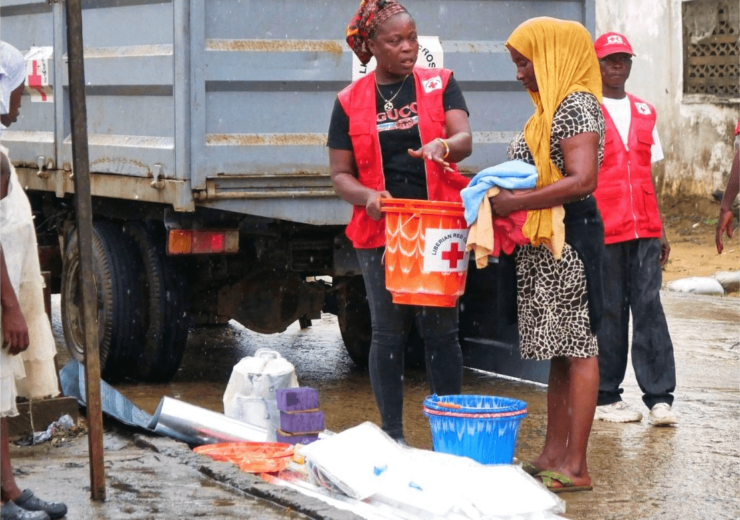DISASTER AND CRISIS RESPONSE
The Liberia National Red Cross Society (LNRCS) plays a pivotal role in protecting lives and livelihoods through a comprehensive Disaster and Crisis Response Program. Grounded in the principles of neutrality, impartiality, and humanity, LNRCS delivers life-saving assistance during emergencies and builds community resilience before, during, and after crises.
Whether faced with natural, man-made, or technological hazards, LNRCS works tirelessly to reduce vulnerabilities and strengthen community capacities across Liberia’s 15 counties. Through strategic partnerships with donors, government entities, and international Red Cross Movement partners, LNRCS is building a responsive, inclusive, and sustainable disaster management system that protects the most vulnerable, especially those affected by poverty, displacement, and social exclusion. At the core of its disaster response is a network of over 2,000 trained volunteers, regional warehouses pre-stocked with essential supplies, and a growing infrastructure that includes the planned Emergency Preparedness and Response Operating Centre (NEWEPROC). LNRCS focuses on a multi-layered approach encompassing emergency relief, preparedness and recovery, early warning and early action, disaster risk reduction, first aid, and livelihood support.
The Society operates under Liberia’s national disaster management framework and uses global Movement tools like Preparedness for Effective Response (PER) and the Safer Access Framework to enhance operational readiness. Through community-based models such as Community-Based Action Teams (CBATs) and localized early warning systems, LNRCS ensures that risk information reaches those most affected, empowering communities to act swiftly and effectively when disasters strike. The LNRCS Disaster Risk Reduction (DRR) strategy is anchored in community participation and ownership, with interventions ranging from hazard mapping and contingency planning to simulation drills, environmental clean-ups, and school-based DRR projects. These efforts are reinforced by a dedicated climate change adaptation project supported by the Swedish Red Cross, targeting vulnerable regions in the southeast. On the humanitarian front, LNRCS provides first-line emergency services, supports Restoring Family Links (RFL) for separated families, and strengthens collaboration with neighboring National Societies to address cross-border emergencies and migration challenges. Furthermore, the Society is scaling up its food security and livelihoods interventions through cash transfers, business recovery, and climate-smart agriculture to help communities recover and thrive post-crisis. With a forward-looking vision, the LNRCS is enhancing its digital tools for disaster data collection, coordination, and management, improving legal recognition of its auxiliary role, and scaling up preparedness through training, equipment procurement, and nationwide outreach. These collective efforts ensure that Liberia’s Red Cross is not only ready to respond to a wide spectrum of evolving crises—be they sudden-onset disasters, epidemics, or protracted emergencies—but is also helping communities build lasting resilience and reclaim hope amid adversity.
LOOKING BACK ON PREVIOUS RESPONSES
The Liberia National Red Cross Society (LNRCS) has established a strong and credible track record in emergency response, particularly during some of Liberia’s most challenging crises. Notably, during the Ebola outbreak, the LNRCS emerged as a frontline responder, playing a vital role in safe and dignified burials, especially in hard-hit areas such as Monrovia and Montserrado. Red Cross volunteers risked their lives to retrieve bodies from streets and homes, helping to prevent further spread of the virus. Beyond burial services, the LNRCS was instrumental in contact tracing, community engagement, and awareness-raising, which were key to controlling the epidemic. The Society’s outstanding service during this crisis earned it national and international recognition, including an award of honor and a medal presented by then-President Ellen Johnson Sirleaf during a ceremony organized by the Crusaders for Peace.
Following the Ebola crisis, the LNRCS continued to demonstrate its readiness and reliability during the COVID-19 pandemic, providing critical support to communities at risk. The Society conducted widespread risk communication, distributed hygiene materials, and delivered life-saving health messages to vulnerable populations across the country. LNRCS also supported infection prevention and control activities, reinforcing public health systems during a time of global uncertainty. Its deep roots in communities, paired with a strong network of trained volunteers, enabled it to reach remote areas and counter misinformation with trusted, science-based information. In addition to epidemics, the LNRCS has consistently responded to a variety of natural disasters, including flash floods, violent storms, and urban fire outbreaks. These responses often include immediate relief services such as emergency shelter, non-food item distribution, first aid, and psychosocial support. The Red Cross has remained a dependable source of aid and hope during times of unexpected hardship, using its experience, volunteer base, and logistical capacity to respond swiftly and effectively. This history of action solidifies LNRCS’s position as a key player in Liberia’s disaster response landscape, deeply trusted by communities and partners alike.
Moving Forward: The LNRCS Emergency Response Vision
As the nature of crises continues to evolve, the Liberia National Red Cross Society (LNRCS) is strategically shifting its focus toward building stronger, more resilient communities through enhanced Emergency Preparedness and Response, Disaster Risk Reduction (DRR), and Disaster Risk Management. Moving forward, LNRCS will intensify efforts to equip communities with the knowledge, tools, and early warning systems necessary to anticipate, withstand, and recover from multiple and overlapping hazards. By establishing Community-Based Early Warning Systems (CEWS) and conducting early action campaigns, LNRCS will empower at-risk communities to take proactive steps in reducing their vulnerability and exposure to climate-induced disasters, health emergencies, and other shocks.
LNRCS also aims to strengthen its institutional capacity to respond more efficiently and effectively to all types of crises—whether sudden-onset, slow-developing, or protracted. The organization will reinforce its auxiliary role in national emergency management by investing in improved response mechanisms, digital tools, and localized preparedness strategies. Central to this forward-looking approach is the engagement of communities as active partners in risk management and resilience-building. Through this integrated and community-driven model, LNRCS will not only continue delivering critical humanitarian relief but also contribute to long-term recovery and development across Liberia.
Key Strategic Objectives the coming years
At Liberia National Red Cross our culture comes to life through three core values:



